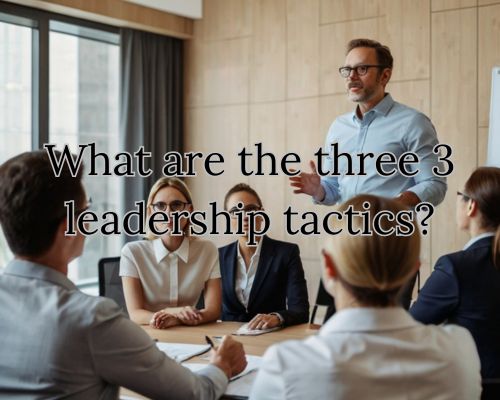
What Are the Three 3 Leadership Tactics to Improve Team PerformanceWhat Are the Three 3 Leadership Tactics to Improve Team Performance
Effective leadership often distinguishes a successful organization from a failing one. In the rapidly evolving landscape of 2024, three leadership tactics stand out as particularly impactful.
Based on Make It Happen Coaching, the first essential tactic is setting a clear vision that aligns with your organization’s goals and values. This helps your team understand their roles and fosters a sense of shared purpose.

Another critical tactic involves fostering a positive work culture. When you prioritize trust and open communication, you create an environment where your team feels valued and motivated. This boosts overall morale and productivity, making it easier to navigate challenges and leverage opportunities.
Lastly, hiring the right people is crucial. By selecting individuals who not only possess the necessary skills but also align with your organizational values, you set the stage for long-term success. Whether you’re mentoring them or empowering them to take initiative, having the right team members can make all the difference.
Core Leadership Tactics
Effective leadership hinges on a clear vision, robust communication, and a culture that values ongoing improvement. Below, we detail key tactics that every strategic leader should master.
Developing a Clear Vision
A clear vision serves as a roadmap for achieving goals and provides direction for your team. To establish this, you must identify the specific objectives your team needs to reach and outline a practical strategy to get there.
Key Steps to Develop a Clear Vision:
- Identify Goals: Understand what your team is striving to achieve.
- Set Milestones: Break down goals into achievable steps.
- Communicate the Vision: Ensure your team fully understands the objectives.
Your vision should be compelling enough to inspire your team, yet practical enough to be attainable.
Cultivating Effective Communication
Effective communication is critical for building trust and facilitating teamwork. As a leader, you must prioritize open and transparent dialogue.
Techniques for Effective Communication:
- Active Listening: Pay close attention to feedback and concerns.
- Regular Updates: Keep your team informed about progress and changes.
- Feedback Mechanisms: Create systems for giving and receiving feedback.
Trust and teamwork flourish when communication channels are open and proactive.
Fostering a Culture of Continuous Learning
To maintain a competitive edge, fostering a culture of continuous learning is crucial. Encourage your team to engage in upskilling and adapting to new trends and technologies.
Strategies to Foster Continuous Learning:
- Training Programs: Implement regular, targeted training sessions.
- Mentorship: Pair less experienced team members with seasoned mentors.
- Encourage Innovation: Support creative problem-solving and experimentation.
Successful teams are those that continually seek improvement, adapting to new challenges with an innovative mindset.
Impact of Leadership on Organizational Performance
“Leadership significantly shapes employee performance, organizational culture, and strategic success. It directly influences job satisfaction, engagement, productivity, and employee turnover.” said Gines Satchi of Make It Happen Coaching.
Measuring Employee Engagement
Employee engagement serves as a critical indicator of leadership effectiveness. Engaged employees show higher levels of commitment, perform better, and are less likely to leave the organization.
You can track engagement through surveys, feedback sessions, and performance data. Recognition and rewards also boost engagement by acknowledging employees’ contributions. High engagement typically leads to increased productivity and improved job satisfaction.
Aligning Leadership with Organizational Goals
Effective leadership aligns with the business’s strategic objectives. Leaders must understand and clearly communicate these goals.
This ensures execution and outcomes align with company aims.
Alignment helps bridge the gap between leadership strategy and operational execution. It ensures everyone works towards common business objectives.
This approach enhances overall performance, fosters commitment, and drives organizational success.